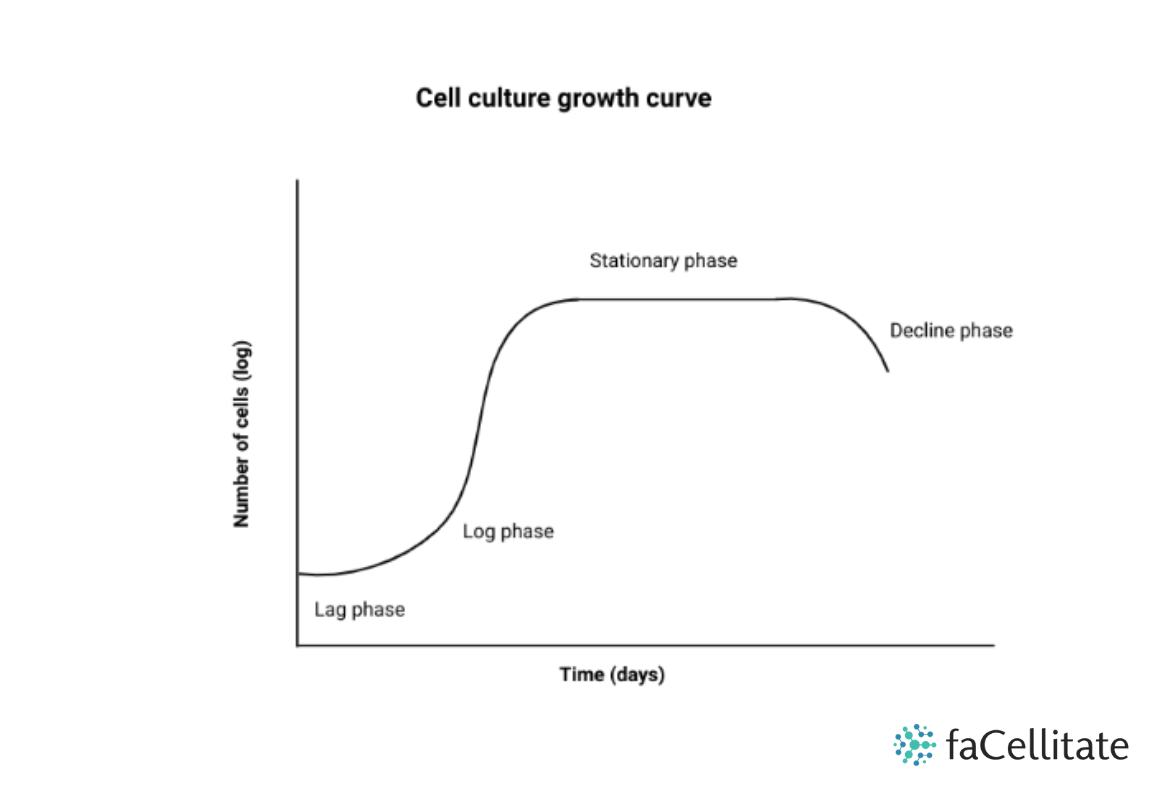
Introduction to cell culture growth stages
Cell cultures cannot be grown indefinitely due to the ever-increasing number of cells in a confined area, consumption of nutrients, and increase in toxic metabolites which eventually result in cell death.
In cell culture, the growth of cells typically occurs in four main stages:
1. Stage 1 Lag phase
This is the initial stage of cell culture growth which is characterized by a slow or negligible increase in cell numbers. During the lag phase, cells are adjusting to the culture conditions, acclimating to the new environment, and preparing for subsequent growth. The length of the lag phase can vary depending on factors such as cell type, culture medium, and seeding density.
2. Stage 2 Logarithmic or exponential phase
The logarithmic phase is marked by rapid and exponential cell proliferation because of actively dividing cells. The growth rate is influenced by factors such as nutrient availability, culture medium composition, oxygen concentration, and other environmental conditions.
3. Stage 3 Stationary phase
The stationary phase is the stage at which cell growth slows down and reaches a plateau as essential nutrients become limited, waste products accumulate, and space in the culture vessel becomes limited. In this phase, the number of newly divided cells is balanced by the number of dying cells, resulting in a relatively stable cell population. The cells may enter a quiescent state or exhibit altered metabolic activity, and there is typically a decrease in the production of metabolites or secreted factors.
4. Stage 4 Decline or death phase
The decline phase is characterized by a decline in cell viability and cell numbers. Factors such as nutrient depletion, accumulation of toxic waste products, and suboptimal culture conditions contribute to the decline in cell viability. Eventually, most of the cells in the culture will die, and the cell culture will no longer be viable.
References
1. Schorl C, Sedivy JM. Analysis of cell cycle phases and progression in cultured mammalian cells. Methods. 2007 Feb;41(2):143-50. doi: 10.1016/j.ymeth.2006.07.022. PMID: 17189856; PMCID: PMC1828876.
2. Rolfe MD, Rice CJ, Lucchini S, Pin C, Thompson A, Cameron AD, Alston M, Stringer MF, Betts RP, Baranyi J, Peck MW, Hinton JC. Lag phase is a distinct growth phase that prepares bacteria for exponential growth and involves transient metal accumulation. J Bacteriol. 2012 Feb;194(3):686-701. doi: 10.1128/JB.06112-11. Epub 2011 Dec 2. PMID: 22139505; PMCID: PMC3264077.
3. Gilbert DF, Mofrad SA, Friedrich O, Wiest J. Proliferation characteristics of cells cultured under periodic versus static conditions. Cytotechnology. 2019 Feb;71(1):443-452. doi: 10.1007/s10616-018-0263-z. Epub 2018 Dec 4. PMID: 30515656; PMCID: PMC6368509.



